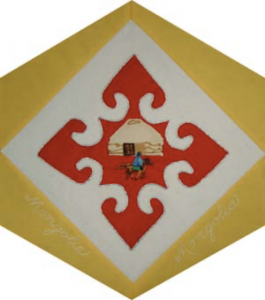Mongolia

The Block
The image of a horse and rider charging at full tilt dominate the Mongolia block. It was inspired by the personal memories and the history of Sha Ren’s homeland. Mongolian boys typically learned at an early age how to ride the sturdy Mongolian war horse (also known as Przewalski’s wild horse) and by adulthood were expert riders and warriors. Horses play a central role in Mongolia’s culture. They are estimated to number around 3 million, which is greater than the human population of the country. Not only are they used for transportation and leisure, but each part of the animal is used. Mares provide milk, while dung is used as fuel since very little wood grows on the steppes. The animals provide meat to eat, hair to make waterproof rope or strings for musical instruments and leather to make boots and, in ancient times, armor.
Stitchers Doreen Stonehouse and Reina Cross selected white felt as the background as it references the traditional yurts (dome-shaped tents of the nomadic Mongolians). The ram’s horn design created is often used to decorate objects for daily use, as well those precious items designated solely for ceremonial purposes.
Cultural Profile
Mongolia, the world’s 18th largest nation by area, is a landlocked country surrounded by China to the south and Russia to the north. For many, just the mention of Mongolia undoubtedly brings to mind Genghis Khan (meaning Universal Ruler), the notorious 13th century conqueror whose fearsome warriors were well-known for their horsemanship. At the height of its power, the Mongolian Empire was the largest empire the world had ever seen, controlling a massive Eurasian territory stretching from Korea to Hungary.
Mongolia’s harsh terrain is largely made up of semi-desert plains, with the Gobi Desert lying in the south-central parts of the country. It experiences a great number of clear, sunny days, which has earned it the nickname “land of the blue sky.” Mongolia is home to many unique animal species, including the endangered snow leopard, the argal (wild sheep), kulan (wild ass), mazalai (Gobi bear) and Przewalski’s wild horse. The largest ethnic group is the Mongols (mostly Khalkha) who make up over 90% of the population. The official language, which is spoken by the majority, is Khalkha Mongol. The language had its own vertical alphabet before it was replaced by the Cyrillic one during the Soviet era. The ancient language writing is being reintroduced in the educational system. There are also ethnic groups speaking Turkic languages, such as Kazakhs, Tuvans, or Tsaatans, known for their reindeer husbandry.
Mongolian culture could be described as homogenous as there are little variations within the population. A little over 30% of the people continue their centuries-old nomadic lifestyle, living in portable, dome-shaped tents of felted wool, the yurts. Such yurts are always set up with the door facing southeast to maximize the amount of light coming in through door and the roof ring. Many Mongolians raise livestock, including yaks, whose milk is not only an important food source, but also provide fuel for lamps. Agriculture still accounts for a large part of the country’s economy, but mining is now the largest sector. This fact that has made Mongolia’s economy one of the fastest growing in the world, but it has also led to many changes to the nomadic lifestyle of Mongolians.
Music is an integral part of daily life and over the years, many of its time-honoured styles have been modernized and standardized. One of the greatest features of Mongolian music that remains unchanged, however, is the traditional long-song, harmonic-like chants. In the west they are sung a cappella (unaccompanied) while in the east they are accompanied by moriin khuur (the horse-head fiddle) and flute. These ‘long songs’ are so called because each syllable of the lyrics is sung over a long duration: a four-minute song can comprise only 10 words. Perhaps the best-known musical form, is traditional throat-singing.
The traditional festival of Naadam, held during the month of July, is the most important sporting event of the year in Mongolia. It showcases the three main sports of wrestling, archery and horse racing. Races cover a long distance of 15 km over the open plain. The jockeys racing the horses are between 5 and 12 years old.
Mongolia’s national costume, called a deel, is worn by both men and women. Those worn for daily life are made with embellished cotton, while ceremonial deels are typically made from silk or satin fabric that is heavily embroidered and decorated with small carvings. Such garments take a long time to create and are only sewn by professionals. The accompanying hats and headgear are elaborately accessorized with semi-precious stones and silver pieces. The boots are also unique in that they are adapted for both winter and summer weather. The outer layer is made from sheepskin while the inside is a removable felt “sock.”
People have been coming to Canada from Mongolia since 1986 and there are over 5,300 people of Mongolian ancestry in Canada.
Sponsor: Joy Clinton, in memoriam Joan and Tom Lock
